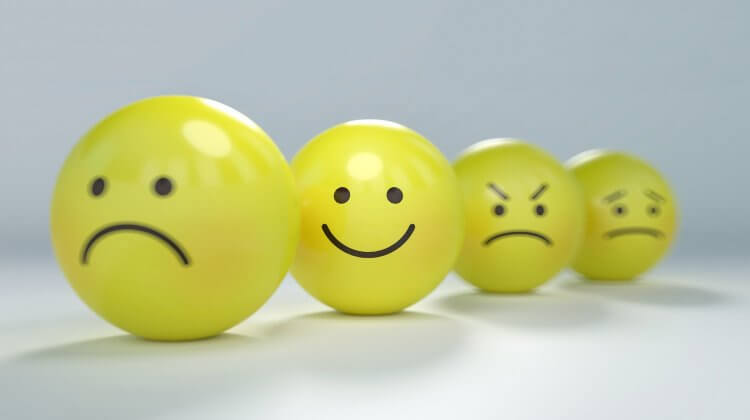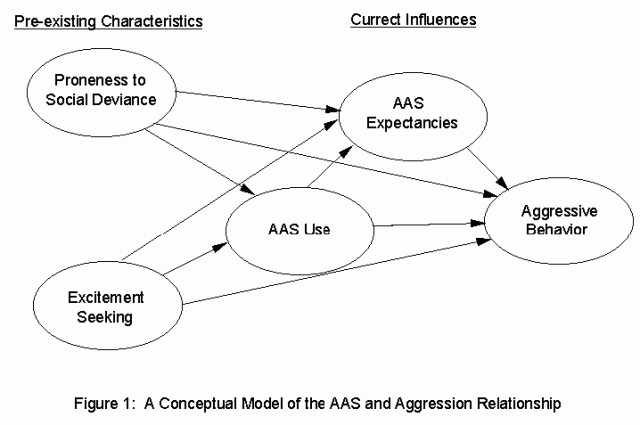
A Conceptual Model and Concluding Remarks
By now many of you might know more than you ever expected to about aggression in AAS users and the role of individual differences and cognitions in the psychological effects of AAS. You may never have realized that there was research on AAS’ psychological effects. And those of you whose interest in AAS includes only questions about “how much and which ones do I need to get huge” probably wonder why anyone would really care whether AAS really do cause aggression. You probably figured that you knew that answer already – of course you do! It takes very little reading of the bodybuilding magazines or the Internet to learn that most people just accept that AAS cause aggression. Many writers or posters to email lists and newsgroups revel in the knowledge that a little T or a lot of pro-hormones will make them intimidating, domineering and aggressive. Of course, if you read my last article, you know that a desire for those outcomes and the assumption that AAS have those effects plays a major part in the behavioral response to AAS, pro-hormones, or any other potential testosterone increasing supplements.
So, why should we care whether the aggressive effects of AAS are biologically, psychologically, socially, or “biopsychosocially” mediated? For one thing, the same psychological processes that might lead AAS to cause aggression can underlie shopping around for the perfect training routine and the next magic supplement. Some lifters go happily along for many years, routine shopping and trying the latest supplements, looking for the magic bullet. Many spend a lot of money and time taking supplements they swear do “something” only to find, in the end, that the research disagrees. Does this deter them? Typically not, because expectations are powerful influences that can be manipulated to capture the attention of potential users. Do such lifters look in the mirror and see what they want to see? They may, whether there are positive changes or may not, because expectancies are also a strong influence on our perceptions. It is a bit like trying on the emperor’s new clothes – we often see what we want to see.
On the other hand, many of you are probably interested in knowing more about the processes that make such licit and illicit substances so attractive and underlie their potential psychological effects. I have merely suggested the undertaking of a more thoughtful exploration of the role of psychological factors in motivating use and “causing” these well-publicized and widely accepted outcomes. Why care? The public (e.g., the media, our colleagues and government) does and they often view resistance trainers in a less than favorable light. We are usually not seen as a particularly thoughtful or healthy group. Thanks to some from among our own group and some researchers who think they are part of the group, we are often seen as narcissistic, obsessive, fanatical, and marginally disordered.
On one hand, you might not care what the general public thinks and, in some ways, you might not be wrong. But what they (whoever they are) think of us, our rituals, and the supplements or drugs associated with our activity, will likely have a powerful influence on the passing of laws that limit access to new and potentially useful products. Many of the arguments used to support potential bans on certain products will suggest that they either are AAS or share many of the effects of AAS. Many of the negative effects highlighted are psychological in nature. If such statements are based on unwarranted interpretations of data or simplistic theories, then arguments against new products will be accepted with equal faith, but be equally flawed. Although we can pretend that we are unaffected by the rest of society, they elect and influence officials who enact legislation that limits our access to useful products on the basis of potentially incomplete or sensationalistic information they hear on the evening news or read on the front page. Ultimately, we become powerless through our illusion of superiority and our isolation.
Do AAS Cause Aggression?
The existing evidence does not support a simple relationship. There is no doubt that aggression occurs in some AAS users. Such aggression is real and can be harmful to users and those around them. But it is not, regardless of dose, inevitable in AAS users. No study reviewed reported, at any dose studied, that all participants reported aggression. If there is no direct, one-to-one relationship between AAS use and aggression across a wide range of doses and users, then we must consider what factors influence the expression of aggression seen in some users.
The literature suggested several hypotheses. For instance, in animal models, the individual’s position in the social hierarchy influenced both aggressive and submissive behavior under AAS administration. AAS users differed from non-users on a number of personality factors and physical characteristics that could predate use and might differentially predict use rather than result from use. As with research on the use of other drugs and drug-related behaviors, many potential moderators predict differences in the exhibition of negative psychological effects of AAS, including aggression, even when the same dose is used. Many of these characteristics may be manifestations of the existing hormonal milieu that might also predict some level of dominance and interact with the addition of endogenous hormones. Research does find a relationship, albeit an imperfect one, between endogenous T levels and dominant behavior (see Dabbs, 2000 for a review).
The research suggests, however, that aggression cannot be solely attributed to the physiological effects of AAS. Some portion of the effects of AAS also results from the expectations of the user. This includes both expectations for the drug effects and their expectation that they have consumed the drug. The effects that can be produced via such expectations can be both physiological and psychological in nature and are just as “real” as those resulting from actual drug administration. They are also just as automatic and “non-volitional” as are biologically mediated effects.
A Conceptual Model of the AAS/Aggression Relationship
I would like to conclude this series of articles by suggesting a conceptual model based on the literature reviewed. This model incorporates the influence of pre-existing individual characteristics that might affect the learning of drug expectancies, the decision to use a drug, and the ultimate expression of problem behavior associated with the use of the drug. Such models have long been posited in research on alcohol use and alcohol-related behavioral problems. The model presented adapts portions of a model from the alcohol-use literature recently reported by Finn and colleagues (Finn, Sharkansky, Brandt, & Turcotte, 2000). In their model, tendencies toward excitement-seeking behavior (disinhibitory behavior and susceptibility to boredom) and proneness toward social deviance (impulsivity, social isolation, problems with authority) influenced both the use of alcohol and the level of expectations for alcohol’s effects. In addition they evaluated the occurrence of alcohol-related problems as a function of deviance proneness, alcohol use, and alcohol expectancies. Excitement seeking tendencies reliably predicted both alcohol use and alcohol expectancies and alcohol expectancies reliably predicted alcohol use. Alcohol use, alcohol expectancies, and deviance proneness predicted the level of alcohol-related problems. The suggested model is intended to serve as a framework within which to summarize and review the major points from the previous discussion of the AAS literature and suggest relationships for further investigation.
Application of the Model to AAS/Aggression
Figure 1 below graphically depicts the application of a structure similar to that of the above model (Finn et al., 2000) to the AAS/aggression relationship. Although the labels of the individual characteristics from the Finn et al. model are maintained, they could also be replaced with other characteristics that differentiated AAS users and non-users (e.g., aggressive traits, “abnormal” personality characteristics, contemplation of use, or dominance/position in the social hierarchy).

The model includes the influence of deviance proneness and excitement seeking on aggression, independent of the use of AAS, because both characteristics have been related to a number of antisocial behaviors, including aggression against others, in the literature. It also includes the influence of those characteristics on the level of AAS expectations, suggesting that pre-existing characteristics enhance the desirability and hence the learning of certain expectancies. Such individual characteristics increase the likelihood of certain behaviors under the influence of AAS and influence the learning of the association between AAS and those outcomes. They may also facilitate the vicarious or observational learning of such expectancies due to their affect on the salience of certain models and outcomes. Those individuals with such characteristics may be more prone to or place more importance on dominance or violence, and therefore be more likely to learn expectancies for aggression than are those who are less prone to such behavior. In sum, consistent with previous discussions of the literature, these characteristics increase the likelihood of use, the potential for learning of certain drug use-related expectations, and the potential for aggressive behavior, independent of use. This portion of the model addresses the purported moderation of the both use and aggression by long-standing individual characteristics.
Included in the current influences portion of the model are the relationships among drug use, cognition, and current outcome behavior, e.g., AAS use, expectancies, and aggression. This portion of the model reflects the mediational role of expectancies in the relationship between use and outcome and the paths included from use to both expectancy and outcome propose that expectancy mediation is partial in nature. Note that there is a direct path from AAS use and aggression as well as an indirect path through expectancy. This acknowledges that some portion of the aggression seen in AAS users is a function of an additive biological effect of endogenous and exogenous testosterone. However, part of the effect passes through the drug expectancies of the user. In this model, use predicts expectancies, both distally (over time) and proximally (during discrete periods of use). This path addresses the findings in the AAS literature that suggest that aggression in AAS users is partly a function of the users’ expectations for aggressive drug effects and their expectation (in an experimental sense) that they have taken the drug (e.g., Bjorkvist, Nygren, Bjorklund, & Bjorkqvist, 1994). Not included for the sake of simplicity and because the model addresses the outcomes of AAS use is a path indicating the role of expectancy in the initiation and maintenance of drug use. Nonetheless this role for expectancy is also important and the relationship between expectancies and use is likely reciprocal in nature – use is motivated by expectancies and also influences the development and elaboration of expectancies. As patterns of use change, expectancies also change and as expectancies change, use is also affected.
Conclusion
Human behavior is a complex phenomenon and efforts to identify single causes or causes within single systems (i.e., social, biological or psychological) are likely to provide a limited picture of reality. Such an effort has suggested that AAS use causes aggression. Perhaps, in part, this results from accepting the association between two behaviors, such as AAS use and aggression, as a cause-effect relationship. The establishment of cause and effect requires not only that two phenomena co-occur (as do AAS use and aggression in some users), but also occur in a specific temporal fashion (as does AAS-related aggression in some users, although true longitudinal studies are lacking). The best test of causation is the experimental method, involving random assignment to drug-administration conditions, the administration of “credible” placebo treatments, and the evaluation of changes in outcomes of interest among the different treatment groups.
A concurrent association between AAS use and aggression has been found in numerous survey-based studies. Studies have attempted to look at the relationship between AAS use and aggression over time and reported some relationship between AAS cycles and increased aggression through the evaluation of retrospective reports. Such studies are not truly longitudinal in nature and are subject to a variety of potential shortcomings (e.g., retrospective memory biases, expectancy effects). Experimental studies have not found consistent evidence for a direct causal relationship between AAS use and aggression and have suggested the possibility for an effect of drug expectancy in aggressive outcomes from AAS, but even these findings are limited in their scope and generality. The existing studies suffer from inconsistencies in assessment strategy (self-report v. observer ratings), as well as the absence of truly credible placeboes.
Society often views cause and effect categorically, tending to favor explanations that are exclusively biological, social, or psychological and to view “biologically caused” behavior as primary and “uncontrollable” and socially or psychologically motivated behavior as secondary and volitional. These views often underlie the desire to determine biological causes for behavior. However, this view is far too simplistic and judgmental. Many human behaviors occur in an automatic fashion but are not exclusively based in our physiology. I hope that this series of articles has made a case for the erroneous nature of such a dichotomy, as well as the need for a more sophisticated theoretical approach to the analysis of AAS-related psychological phenomena.
References:
Bjorkqvist, K., Nygren, T., Bjorklund, A.C., & Bjorkqvist, S.E. (1994). Testosterone intake and aggressiveness: Real effect or anticipation. Aggressive Behavior, 20, 17-26.
Dabbs, J.M. (2000). Heroes, rogues, and lovers: Testosterone and behavior. Mcgraw-Hill: New York.
Finn, P.R., Sharkansky, E.J., Brandt, K.M., Turcotte, N. (2000). The effects of familial risk, personality, and expectancies on alcohol use and abuse. Journal of Abnormal Psychology, 109, 122-133.
About the author
Jack Darkes, Ph.D. is a Clinical Psychologist and currently the Director of the Psychological Services Center in the Department of Psychology at the University of South Florida. He is well-known and respected both nationally and internationally for his research on psychological factors related to substance use and abuse. He has applied his experience to an examination of the use and behavioral effects of anabolic-androgenic steroids (AAS) and his writings on AAS are well-known to readers of various internet fitness and bodybuilding websites.

Leave a Reply
You must be logged in to post a comment.